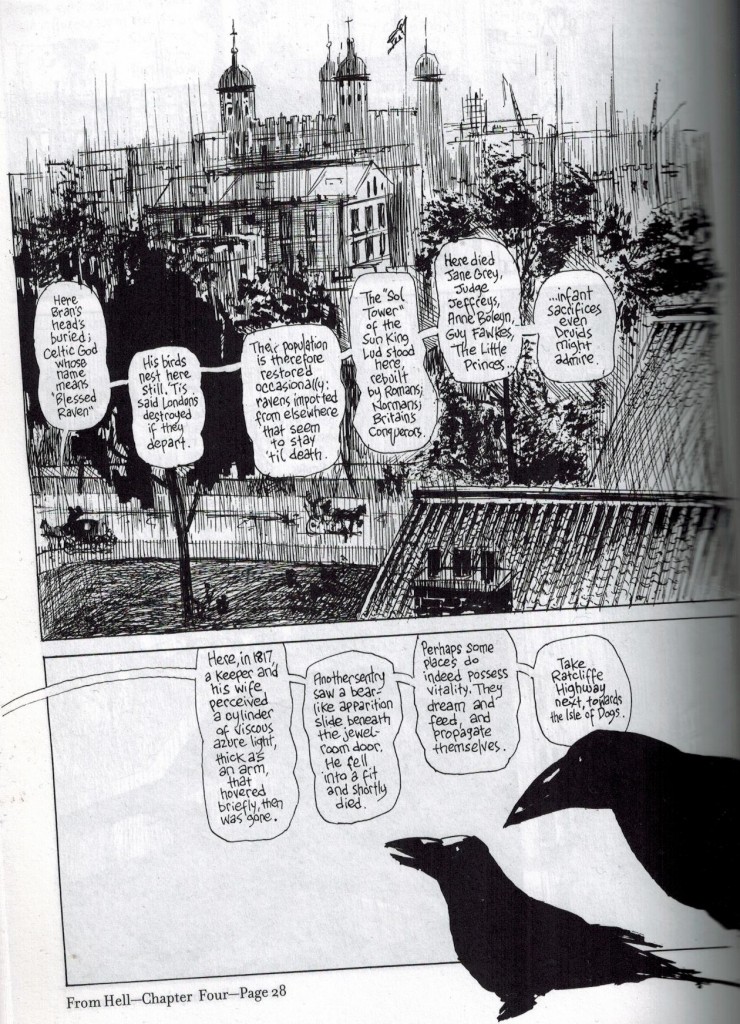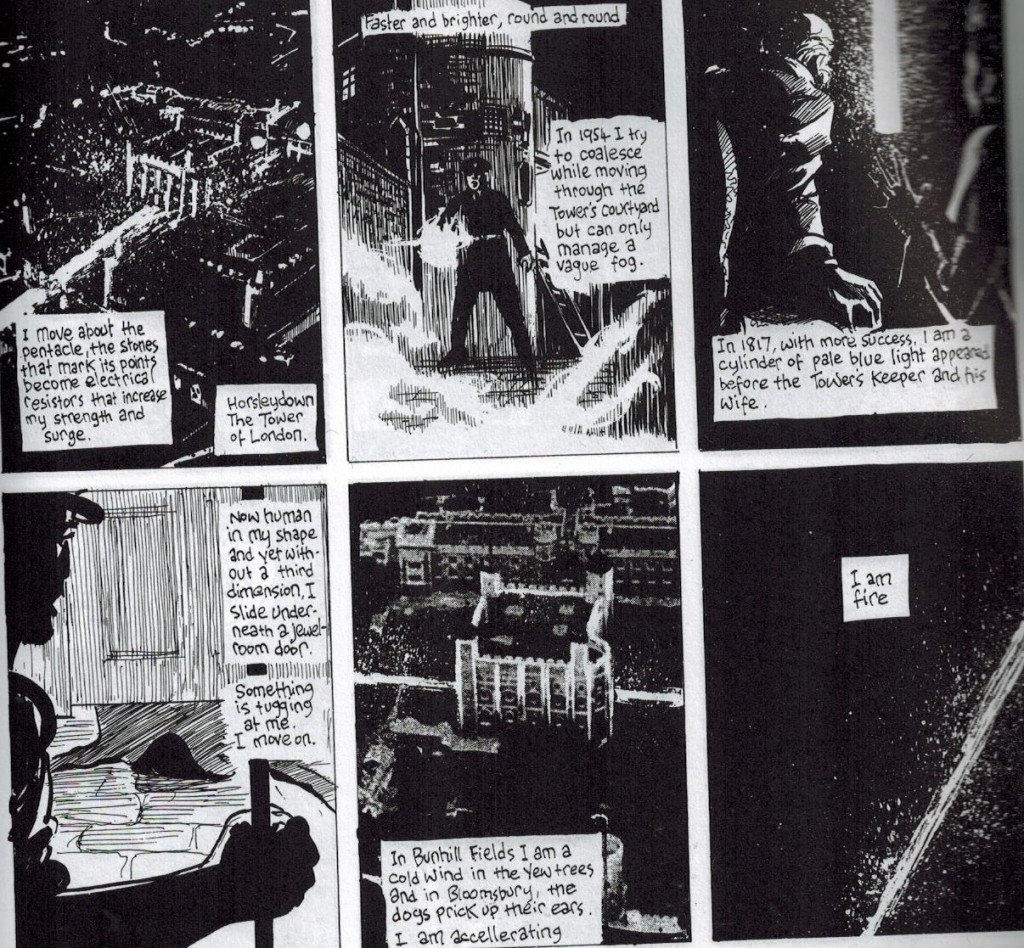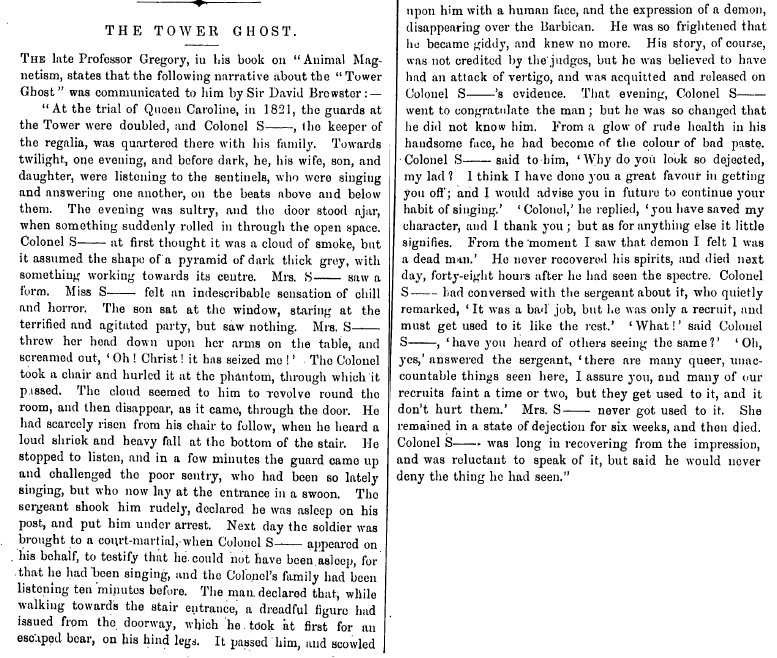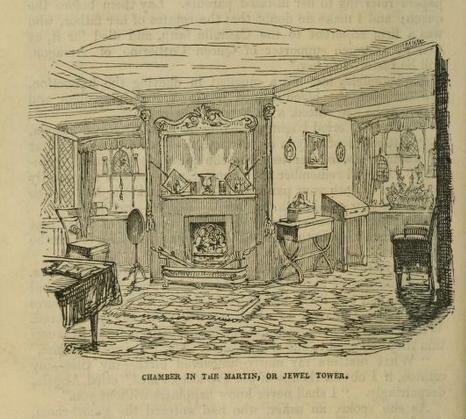The Tower Monster #1: The Witness Account July 15, 2015
Author: Beach Combing | in : Modern , trackbackThere follows the single most interesting ghost story Beach has ever read. Perhaps part of its fascination is that it is not clear that it is a ghost story: though something bizarre is certainly going on. In any case, all began when in 1860, in the tenth volume (new series) of Notes and Queries K.B sent in an innocent inquiry. It was to lead to one of the strangest replies ever received by that review.
Ghost in the Tower. Is there not a ghost story connected with the Tower of London? And what is it ? Has not the ghost, or appearance, been seen once at least during this century, and with fatal results ? K. B.
Beach has not included the whole text here but he has a pdf on the Tower monster with all the relevant documents. It is about 15 mb: he’ll gladly send to anyone who is interested. The man who wrote was Edmund Lenthal Swifte. Swifte had been appointed Keeper of the Crown Jewels in the Tower in 1814 and remained in that job until 1852. This little account is interesting because it is so raw: an eyewitness sees something that is later placed in the ghost category. But really what is going on here? It is the kind of incident that some modern Forteans call ‘High Strangeness’.
One Saturday night in October, 1817, about ‘the witching hour,’ I was at supper with my then wife, our little boy, and her sister, in the sitting-room of the Jewel House, which – then comparatively modernised – is said to have been the ‘doleful prison’ of Anna Boleyn, and of the ten bishops whom Oliver Cromwell piously accommodated therein. For an accurate picture of the locus in quo my scene is laid, I refer to George Cruikshank’s wood-cut in p. 384. of Ainsworth’s Tower of London [included at the head of this post]; and I am persuaded that my gallant successor in office, Colonel Wyndham, will not refuse its collation with my statement. The room was – as it still is – irregularly shaped, having three doors and two windows, which last are cut nearly nine feet deep into the outer wall; between these is a chimney-piece projecting far into the room, and (then) surmounted with a large oil picture. On the night in question, the doors were all closed, heavy and dark cloth curtains were let down over the windows, and the only light in the room was that of two candles on the table. I sat at the foot of the table, my son on my right hand, his mother fronting the chimney-piece, and her sister on the opposite side.
And now the fun begins.
I had offered a glass of wine and water to my wife, when, on putting it to her lips, she paused, and exclaimed, ‘Good God ! what is that?’ I looked up, and saw a cylindrical figure, like a glass tube, seemingly about the thickness of my arm, and hovering between the ceiling and the table: its contents appeared to be a dense fluid, white and pale azure, like to the gathering of a summer cloud, and incessantly rolling and mingling within the cylinder. This lasted about two minutes; when it began slowly to move before my sister-in-law; then, following the oblong shape of the table, before my son and myself; passing behind my wife, it paused for a moment over her right shoulder [observe, there was no mirror opposite to her in which she could then behold it]. Instantly she crouched down, and with both hands covering her shoulder, she shrieked out, ‘Oh, Christ! it has seized me!’ Even now, while writing, I feel the fresh horror of that moment. I caught up my chair, struck at the wainscot behind her, rushed up stairs to the other children’s room, and told the terrified nurse what I had seen. Meanwhile, the other domestics had hurried into the parlour, where their mistress recounted to them the scene, even as I was detailing it above stairs.
Let’s take a breather here. Swifte does not say that the cylinder disappeared, but in a later clarification he adds that it: disappeared in the recess of the opposite window. Alternatively, Swifte could have run upstairs just through sheer terror, which he then communicated to the nurse. The next part is one of several very confusing elements in this story.
The marvel – some will say the absurdity – of all this is enhanced by the fact that neither my sister-in-law nor my son beheld this ‘appearance’ – as K. B. rightly terms it – though to their mortal vision it was as ‘apparent’ as to my wife’s and mine.
So to be clear: only two of the four occupants of the room actually saw the cylinder. (The boy, we learn elsewhere, was six). The next comments give some sense, whether he be right or wrong, of Swifte’s intelligence.
When I the next morning related the night’s horrors to our chaplain, after the service in the Tower church, he asked me, might not one person have his natural senses deceived? And if one, why might not two? My answer was, if two, why not two thousand? an argument which would reduce history, secular or sacred, to a fable. But why should I here discuss things not dreamed of in our philosophy?
Swifte clearly believe that the cylinder was or that it might be a ghost.
I am bound to add, that, shortly before this strange event, some young lady-residents in the Tower had been, I know not wherefore, suspected of making phantasmagorial experiments at their windows, which, be it observed, had no command whatever on any windows in my dwelling. An additional sentry was accordingly posted, so as to overlook any such attempt.
Beach has read this last sentence and can only take it to mean that a sentry was put on to stop girls summoning spirits or pretending to be ghosts! Something that Swifte confirms elsewhere. A second very curious element now follows. It is the collision of these two episodes that is so extraordinary.
Happen, however, as it might, following hard at heel the visitation of my household, one of the night sentries at the Jewel Office was, as he said, alarmed by a figure like a huge bear issuing from underneath the door; he thrust at it with his bayonet, which stuck in the door, even as my chair dinted the wainscot; he dropped in a fit, and was carried senseless to the guard-room. His fellow-sentry declared that the man was neither asleep nor drunk, he himself having seen him the moment before awake and sober. Of all this, I avouch nothing more than that I saw the poor man in the guard-house prostrated with terror, and that in two or three days the ‘fatal result,’ be it of fact or of fancy, was — that he died. My story may claim more space than ‘N. & Q.’ can afford: desiring to be circumstantial, I have been diffuse. This I leave to the Editor’s discretion : let it only be understood, that to all which I have herein set forth as seen by myself, I absolutely pledge my faith and my honour.
It is very important to note that the bear and the cylinder event are connected at least in Swifte’s mind: ‘even as my chair dinted the waiscot’. In fact, this surely must be interpreted as the escaping cylinder? If it had been quite separate we could have just ignored the matter or imagined that a guard had had a fatal epileptic fit including disturbing hallucinations.
Beach will follow up with some supplementary material on this most interesting case in the next days, but any initial impressions: drbeachcombing AT yahoo DOT com
15 July 2015: RR writes in, ‘This is a fascinating account of a very peculiar event.
For over 45 years, I have been reading books and articles on paranormal subjects, especially UFOs, a field which has long ago fallen into discredit by serious scientists.
Despite this, I have come to the conclusion that UFOs are nothing more than what Paul Devereaux called “earthlights” around 30 years ago. They are a relative of earthquake lights which have only recently been confirmed by scientists. Earthlights have been confirmed in labs in small scales under the term “tribolumination”. When rocks undergo extreme pressure, tiny coloured lights appear above the surface of the rocks which can change shape, merge, fly in formation at high speeds relative to the size of the lights and suddenly disappear.
How does this relate to the article?
Part of the theory of earthlights is that they appear as classic UFOs when deep rock formations in the earth undergo extreme pressure changes. The lights which are produced can appear as saucers, spheres, blobs of light, triangular lights or cylinders. All credible reports of UFOs from the “classic” period between 1946 and 1980 and after describe these shapes.
I think that said earthlights can also appear indoors like ball lightning. Given that the Tower of London is made up or rocks under extreme pressure, this is a likely explanation for the “Tower Monster”.
What the witnesses in this incident saw was probably an indoor “earthlight” in the shape of a cylinder.
But why were only the parents alarmed by it or why didn’t all the family members and staff see the phenomenon?
Once again, there may be an explanation. I call it a neurological “allergic response” to what causes these lights.
I suspect that earthlights may cause hallucinations in some people while others may only see the lights, if they see anything at all.
This is probably why the mother said “it’s got me”. She was probably affected by the object in the same way the abductees are.
Once example of such an event was reported in a book by Jacques Vallee (sadly I can’t remember which one). It’s the story of Paulo Gaetano and his anonymous friend who were traveling together in Paulo’s car in a mountainous part of Brazil in the 1970s. His friend reported to police that Paulo was acting strange and screaming about a UFO, suddenly stopped the car, got out of it, then fell against the car and hurt his arm. Paulo’s report to the police is of a classic alien abduction in which the aliens operated on the arm he fell against.
Thanks RR!
21 July 2015: Anonymous Reader writes in 1843 an obituary ‘the Protestant church at Athens Nov 20 At Hobart Town aged 32 Theophilus Swifte esq eldest son Edmund Lenthall Swifte esq the of her Majesty’s Jewel House His death was occasioned by an apothecary who negligently administered too large a quantity of laudanum.’
Swifte does (Beach writes) refer to his son being dead by 1860.
Anonymous Reader goes on to note:
so from your presentation, I see three oddities:
the floating cylinder
the seeing by only half the people
the bear appearance
I’ll just comment on the first.
MANY sightings of floating things, spheres, cylinders, dazzling, lit, colored, are likely of ball lightning, which does appear in all those different colors, shapes, brightnesses, smells, durations, etc etc. Usually associated with lightning storms, but sometimes, 5% of the time, like lightning, out of nowhere or out of the ground. sizes can be from pea size to village size.
but none that I know of in 10,000 sightings, in bear shape/form.
there are a few possible normal explanations why only some saw the cylinder.
but no, I don’t recollect ANY of the accounts of ball lightning where only some of those present saw the ball.
29 Aug 2015: Roger Clarke (author of a notable ghost book) wrote ‘I have first hand experience of walking round the Tower of London after dark (almost nobody gets to do this as it’s a high-security establishment guarded by the regular British Army) and was a personal friend of George Abbott, who wrote the best-known book on Tower ghosts. I talk about the story extensively in my book. It’s worth remembering Swifte rather fancied himself as a writer and his account of a cylinder of light that ‘seized’ his wife (seized as it gave her some kind of fit, or seizure, not as it busting her corset) is completely unique. In my experience of reading a great many accounts of ghost-stories, I’m innately suspicious of a story that is unique and shares no major feature with other accounts. I did a bit of research on Swifte. He was an Irishman who sought preferment with the king by writing a long poem in his honour; essentially, he was a writer and a fantasist. He was rewarded for his pointed royalism with the Tower job. There’s something of a tradition of the upper middle-class folklorist from about this time…
11 Oct 2015: Chris from Haunted Ohio Books sends in this reference. The Spiritual Magazine 1874, 509-520 includes, conveniently all the Notes and Queries letters.
2 May 2016: Southern Man writes in with this. ‘Unsurprisingly the tower monster features in Alan Moore’s From Hell. I thought you might enjoy a scan.’

Here is another section from the end where an ecstatic, shamanic William Gull (dying) himself becomes these demonic forms (which he had earlier described)

17 Nov 2016: Loes writes in with a variant. This is from Two Worlds, no 2, 1888, p 652. Huge thanks to Loes.




